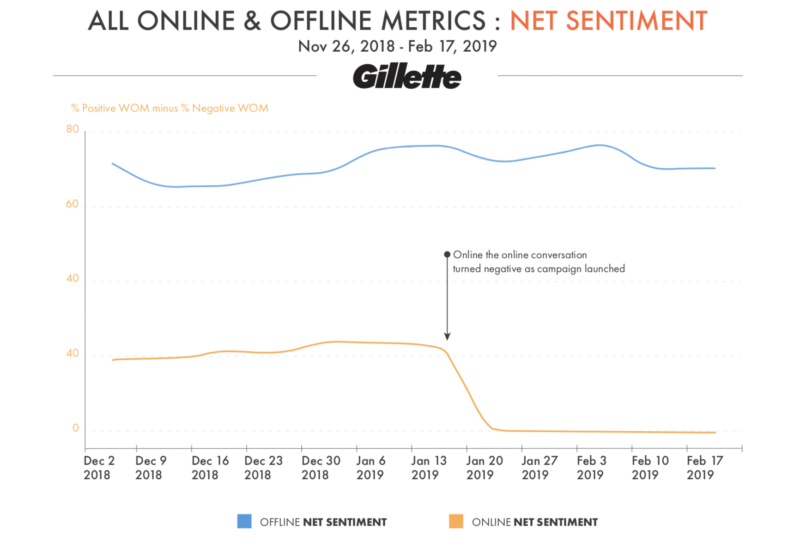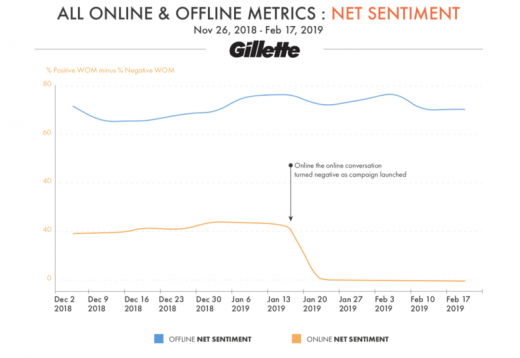Report: There’s almost no correlation between online and offline consumer conversations
Brands can’t rely on “social media listening” as a proxy for broader consumer sentiment
Online and offline consumer conversations are largely separate. That’s the conclusion of a large, recent study from Engagement Labs, which affirms earlier data and analysis by the company, as well as others.
Analysis of conversations about 500 brands. Engagement Labs performed what it describes as “a comprehensive analysis, lining up the week-to-week trends for the online and offline conversation trends” of 500 brands across multiple product categories. The company examined “conversation volume, sentiment, brand sharing (talking about and sharing brand marketing), and influence (connecting with everyday influencers).”
Engagement Labs uses a mix of surveys and online social media monitoring to gauge consumer sentiment and actions. It determined that across these multiple metrics there was not “a meaningful correlation between online and offline discussions for brands.” The top-level takeaways for marketers and brands are the following:
- Brands can’t rely on “social media listening” as a proxy for broader consumer sentiment or to evaluate the complete impact of any decision or campaign
- Online and offline conversations need to be measured and managed separately
- Brands need to clearly understand the differences between these distinct audiences

Alignment between online and offline sentiment does occur. This is not to say that there’s never a connection or correlation between online and offline sentiment. It can and does happen. Think for example, of United Airlines when it ordered the forced removal of an uncooperative passenger from one of its planes in 2017 in a highly publicized incident. That drove negative sentiment universally. However, recovery of the brand occurred at different rates online and off.
The general proposition here is that “monitoring social media cannot reveal what is happening in terms of offline conversations.” This may sound counter-intuitive because “everyone’s online except people over 65, right?” But this is what Engagement Labs’ data show. It’s also what location intelligence company Gravy has shown in other contexts.
Gillette and Herbal Essences prove the rule. There are multiple examples cited in the report of divergence or discrepancies between online and offline sentiment. For example, Herbal Essences received considerable negative social media attention in 2018 for being a Fox News advertiser. However “the anti-Fox News campaign hardly registered in the offline conversations.” The company also points out that ” in May 2018, a sponsorship of ABC’s coverage of the Royal Wedding . . . coincided with a drop in offline sentiment that did not occur online.”
Another high-profile example is Gillette’s 2019 “toxic masculinity” campaign, which drove a roughly 4000% increase in online mentions according to Engagement Labs. A large percentage of those were highly negative or critical. However, “real-world conversations about Gillette were decidedly different and did not experience a similar negative reaction,” although they increased in volume.
What to do about it. When brands take political stands or controversial positions, as Gillette did or as Nike has, they must be thoughtful about the potential impact on their various audience segments. Brands must also recognize that online sentiment may be more extreme than in “the real world.”
Sometimes a controversy that flares online will flame out quickly and have virtually no impact offline. Conversely, in some cases, offline reaction (positive or negative) won’t be mirrored online. Marketers should, therefore, treat online and offline word-of-mouth separately, with distinct tactics and monitoring tools for both sets of audiences.
As Engagement Labs has previously said, “Success in one ecosystem does not translate automatically into the other. Only a marketer prepared with a good map, a smart strategy, and the right gear can expect to thrive in both the online and the offline ecosystems.”
Marketing Land – Internet Marketing News, Strategies & Tips
(25)



